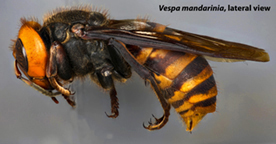ARS Asian Giant Hornet Specialist Is Part of New Exhibit at the National Museum of Natural History
Contact: Kim Kaplan
Email: Kim Kaplan
Agricultural Research Service research entomologist Matt Buffington is part of a new exhibit "Our Places: Connecting People and Nature" at the Smithsonian National Museum of Natural History (NMNH) in Washington DC. The exhibit explores how peoples' experiences with nature inspire them as well as offering visitors a chance to learn about how dedicated scientists and community members work to protect the environment.
Among the objects in "Our Places," is part of the actual Asian giant hornet "Nest Zero," the first place these huge hornets set up housekeeping when they arrived in Washington State from Asia in October 2019. Asian giant hornets are a concern because sometimes they can feed on honey bees, buzzsawing through a colony in minutes, and they deliver extremely painful stings to people, but fortunately only if provoked. To quell their spread, Washington State Department of Agriculture, the Agricultural Research Service (ARS) and the Animal and Plant Health Inspection Service (APHIS), both part of the U.S. Department of Agriculture, worked to locate and remove the invasive hornets' nest.
ARS developed a specialized lure and trap to attract and live trap the Asian giant hornets. APHIS provided a radio tracker to tie onto captured Asian giant hornets so they could be tracked back to Nest Zero. The nest was then dispatched and is now part of the exhibit.
But the capture was just the start of ARS' work with Asian giant hornets.
Buffington, who is part of the ARS Systematic Entomology Laboratory at the Beltsville Agricultural Research Center, was instrumental in seeing that Asian giant hornet samples from Nest Zero were flash frozen and eventually placed in cryopreservation at the NMNH's Biorepository in Suitland, Maryland.
"These hornets were moved directly into long-term preservation. They will be the genetic gold standard for comparing other Asian giant hornets found in this country," he said. Other ARS scientists have mapped their genome and will be comparing it to the genomes of Asian giant hornets from other locations with an eye to building a database that may contribute to refined identifications.
 A new exhibit at the Smithsonian National Museum of Natural History includes ARS work on the Asian giant hornet. See a short video.
A new exhibit at the Smithsonian National Museum of Natural History includes ARS work on the Asian giant hornet. See a short video.
From his other office in the NMNH, Buffington helps curate the National Insect Collection as an expert on wasps and hornets. The Smithsonian and ARS have a long history of close cooperation and partnership on research projects.
"The National Insect Collection is our country's record of what insects occur in the United States; without this essential resource we'd have no way of verifying that the insects we captured in Washington state were indeed Asian giant hornets, Vespa mandarinia, and not one of several U.S. native look alike hornets that are not problems insects," Buffington said. "That's an important role, ensuring that non-native invasive insects that can damage our environment are properly identified and removed while not accidently harming our native species."
Understanding and properly cataloging the global biodiversity of insects is essential to the U.S. and the world agricultural economies just as much as it is about the protection of our natural resources.
"And everyone can play a role in the protection of natural and ag resources," Buffington said. "We are currently in a massive insect species decline. Everyone should be concerned about this as it's a sign of a larger global health crisis that is affecting our species now."
The Agricultural Research Service is the U.S. Department of Agriculture's chief scientific in-house research agency. Daily, ARS focuses on solutions to agricultural problems affecting America. Each dollar invested in agricultural research results in $17 of economic impact.
